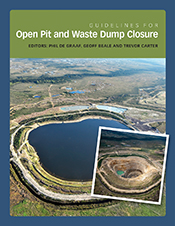Guidelines for Evaluating Water in Pit Slope Stability
Details the hydrogeological procedures that should be followed when performing open pit slope stability design studies.
Guidelines for Evaluating Water in Pit Slope Stability is a comprehensive account of the hydrogeological procedures that should be followed when performing open pit slope stability design studies. Created as an outcome of the Large Open Pit (LOP) project, an international research and technology transfer project on the stability of rock slopes in open pit mines, this book expands on the hydrogeological model chapter in the LOP project's previous book Guidelines for Open Pit Slope Design (Read & Stacey, 2009; CSIRO PUBLISHING). + Full description
The book comprises six sections which outline the latest technology and best practice procedures for hydrogeological investigations. The sections cover: the framework used to assess the effect of water in slope stability; how water pressures are measured and tested in the field; how a conceptual hydrogeological model is prepared; how water pressures are modelled numerically; how slope depressurisation systems are implemented; and how the performance of a slope depressurisation program is monitored and reconciled with the design.
Guidelines for Evaluating Water in Pit Slope Stability offers slope design practitioners a road map that will help them decide how to investigate and treat water pressures in pit slopes. It provides guidance and essential information for mining and civil engineers, geotechnical engineers, engineering geologists and hydrogeologists involved in the investigation, design and construction of stable rock slopes.
- Short descriptionNews
This title is no longer available in print format, but can still be purchased as an eBook.
The print edition of this title is published outside of Australia and New Zealand by CRC Press (external link).
Details
ePDF | January 2014ISBN: 9780643108363
Publisher: CSIRO Publishing
Available from eRetailers
ePUB | January 2014
ISBN: 9780643108370
Publisher: CSIRO Publishing
Available from eRetailers
Features
- Provides best practice procedures for performing hydrogeological investigations in the field, developing conceptual hydrogeological models, modelling water pressure, depressurizing rock slopes and monitoring systems, actual slope performance, and water risk management.
- Offers guidance and essential information on the latest technologies and innovations for all those involved in the investigation, design and construction of stable rock slopes.
- Developed and written by industry experts with extensive knowledge and experience in the stability of rock slopes in open pit mines.
- Provides comprehensive guidelines for slope design practitioners, written in an accessible style and extensively illustrated.
Contents
Introduction1 Scope of LOP project hydrogeological studies
2 General impact of water on mining
3 Cost of managing water in slope stability
4 Goals of managing water in slope stability
5 General planning for mine water management
FRAMEWORK: ASSESSING WATER IN SLOPE STABILITY
1.1 Fundamental parameters
1.2 The hydrogeological model
1.3 Managing water in open pit mines
SITE CHARACTERISATION
2.1 Planning field programs
2.2 Implementing field programs
2.3 Presentation, analysis and storage of data
PREPARING A CONCEPTUAL HYDROGEOLOGICAL MODEL
3.1 Introduction
3.2 Components of the conceptual model
3.3 Research outcomes from Diavik
3.4 Discrete Fracture Network (DFN) modelling
3.5 Summary of case studies
3.6 Factors contributing to a slope-scale conceptual model
3.7 Conclusions
NUMERICAL MODEL
4.1 Planning a numerical model
4.2 Development of numerical groundwater flow models
4.3 Use of pore pressures in numerical stability analyses
IMPLEMENTATION OF SLOPE DEPRESSURISATION SYSTEMS
5.1 Planning slope depressurisation systems
5.2 Implementing a groundwater-control program
5.3 Control of surface water
MONITORING AND DESIGN RECONCILIATION
6.1 Monitoring
6.2 Performance assessment
6.3 Water risk management
APPENDIX 1
Darcy’s law
Head and pressure
Darcy’s law in field situations
Flow in three dimensions
APPENDIX 2
1 Summary of drilling methods commonly used in mine hydrogeology investigations
2 Standardised hydrogeological logging form for use with RC drilling
3 Interpretation of data collected while RC drilling
4. Guidelines for drill-stem injection tests
5 Guidelines for running and interpreting hydraulic tests
6. Guidelines for the installation of grouted-in vibrating wire piezometer strings
7 Westbay multilevel system
APPENDIX 3
1 Background
2 Hydrograph analysis
3. DFN modelling
A3.2 DFN model building
3.3 DFN model validation
3.4 Summary
APPENDIX 4
4.1 Escondida East Wall
4.2 Chuquicamata
4.3 Radomiro Tomic
4.4 Antamina West wall
4.5 Jwaneng Diamond Mine South-east Wall
4.6 Cowal Gold Mine (CGM)
4.7 Whaleback South wall
4.9 La Quinua, Peru
APPENDIX 5
Case Study 1: Numerical modelling of the Northwest wall of the Diavik A154 pit
Case Study 2: Numerical modelling of the marl sequence at the Cobre Las Cruces mine, Andalucía, Spain
APPENDIX 6
1.0 The lattice formulation
2.0 Features of the Lattice Approach
3.0 Example application
4.0 Validation of Slope Model using experimental data from Coaraze test site, France
4.1 Geometry
4.2 Boundary conditions
4.3 Building the model
4.4 Simulation results
4.5 Conclusions
APPENDIX 7
Introduction
Water level monitoring
Summary and conclusions
Index
Authors
John Read is an engineering geologist with over 45 years' experience and particular expertise in the stability of rock slopes in large open pit mines. He has BSc and MSc (Hons) degrees in geology from the University of New Zealand and Canterbury University, NZ, a PhD in geotechnical engineering from Purdue University, USA, and is a chartered professional engineer in Australia. Dr Read began his own geotechnical engineering practice in 1990, since when he has specialised in slope stability and open pit mine slope design and investigation tasks in Australia, Fiji, Papua New Guinea, Brazil, Argentina, Chile, Canada, South Africa and Zambia.From 1994 to 2004 Dr Read was Deputy Chief of CSIRO Exploration & Mining and Executive Manager of the Queensland Centre for Advanced Technologies, Brisbane. He stepped back from these positions in April 2004 to initiate and lead the Large Open Pit (LOP) project, an international research and technology transfer project on the stability of rock slopes in open pit mines.
Geoff Beale is a worldwide expert in mine hydrology and mine water management with 37 years' hands-on experience in the extractive and mining industries. He travels globally and works as a senior technical expert for many of the large mining houses. Geoff is most noted for his global knowledge of open pit and underground mine dewatering projects, and has been involved with many of the world’s largest dewatering operations. In addition, he has broad experience in the operation and environmental aspects of leach pads, waste rock facilities and tailing systems, and also has extensive mine closure experience. Over the past 15 years, Geoff has studied the behaviour of pore pressure in pit slopes and how this relates to the overall slope design, and has researched the interaction between groundwater flow and rock mass deformation in low-permeability environments using a number of datasets from operating mines.
Geoff Beale graduated from Lancaster University (UK) in 1975 and has since worked on over 250 mining projects in over 50 countries, in all mining commodities, and in all of the world’s climatic regions. He was one of the founding members of the Water Management Consultants Group in 1989, and was principal with the company through to the time of its acquisition by Schlumberger in 2007. He has worked for Schlumberger since 2007.








